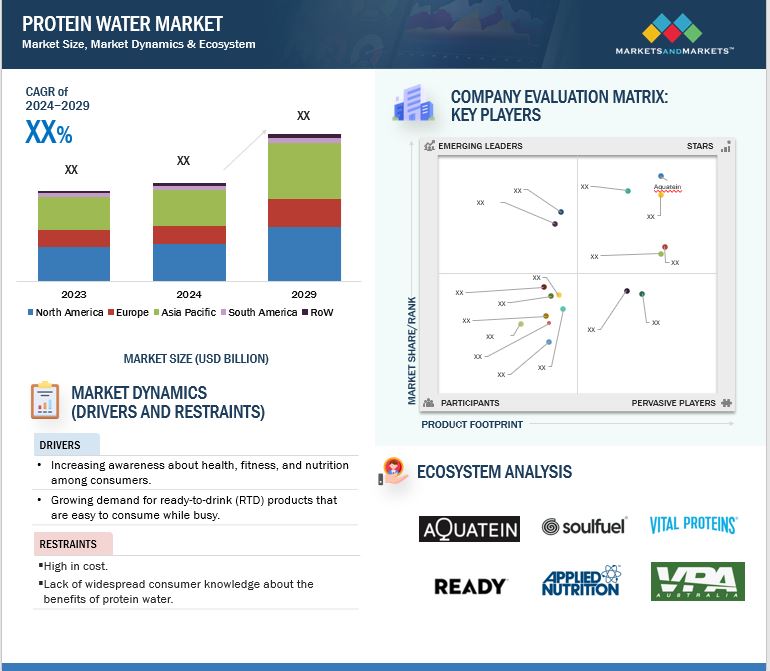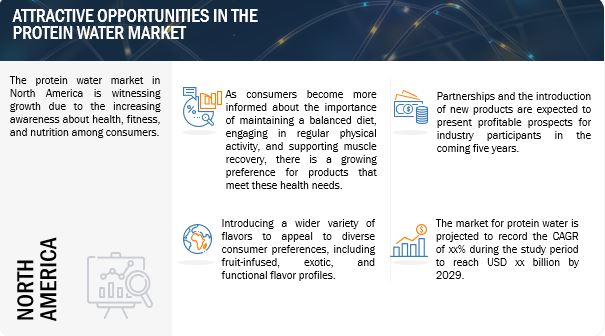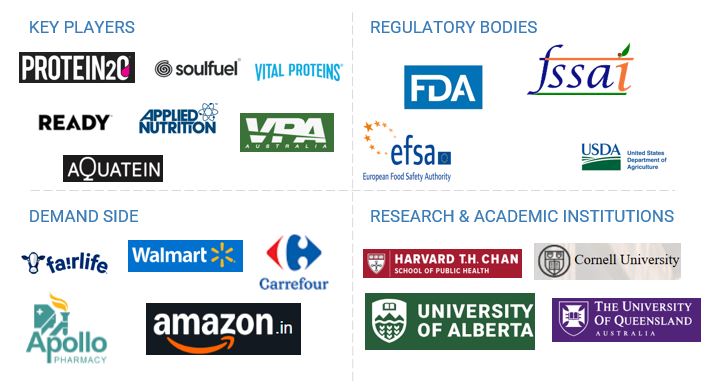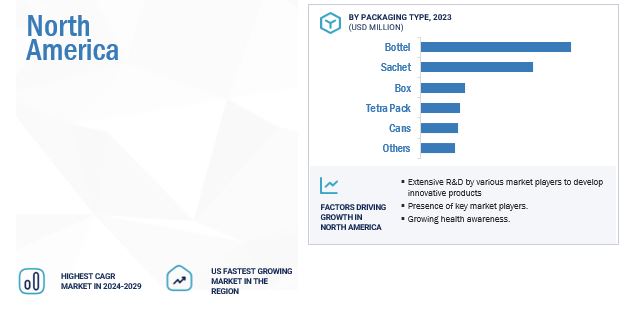Protein Water Market
The global protein water market is projected to expand from USD xx million in 2024 to USD xx million by 2029, at a CAGR of xx% during the forecast period. The global protein water market is growing fast due to increasing health consciousness, demand for convenient and functional beverages, and innovation in protein formulations. Consumers are now prioritizing fitness, hydration, and protein intake, and protein water has emerged as a convenient low-calorie, high-protein alternative to traditional protein shakes. The rising interest in plant-based proteins, clean-label products, and the addition of functional ingredients, such as vitamins, electrolytes, and collagen primarily drives this growth. The primary markets are North America, Europe, and the Asia-Pacific, where sustainability and premium products are gaining more importance. Challenges include taste preferences, price sensitivity, and fragmentation of the market. Brand innovation and differentiation will therefore be key. As such, protein water will have immense potential in the health and wellness beverage market.
Global Protein Water Market Trends


Attractive Opportunities For Players In The Protein Water Market
Drivers:
The increasing awareness about health, fitness, and nutrition among consumers is driving protein water market growth.
The awareness about health, fitness, and nutrition among consumers has played a significant role in the growth of the protein water market, as most people have started to look after their health through healthier and functional beverage choices. With attention being given to a healthier lifestyle, consumers have been seeking low-calorie, convenient products that provide them with nutritional benefits. The combination of hydration and high-quality protein in protein water portrays these trends perfectly.
Increasing fitness culture, especially at-home workouts during the COVID-19 pandemic, has been creating a growing demand for protein-enriched beverages. Moreover, the increasing demand for plant-based diets also fuels the need for plant-based protein waters. Companies such as Protein2o provide plant-based protein water products to meet the growing number of consumers looking for dairy-free and vegan options. The trend towards plant-based protein is a microcosm of the greater shifts in health and nutrition consciousness, in which people are becoming more conscious of their choices and the impact those choices have on their lives, whether it be sustainability or the ethics of production. Thus, considering the above parameters, increasing awareness about health, fitness, and nutrition among consumers is driving protein water market growth.
Restraints:
High cost of protein water.
The higher price of protein water products than usual beverages can be a significant restraint for the market, especially among cost-sensitive consumers. Protein water is marketed often as a premium functional beverage because of its added nutritional benefits, such as high protein content and low calories.
For budget-sensitive consumers, the price of protein water may be too high compared to other more affordable options such as bottled water, sports drinks, or flavored water. This price barrier, therefore, will limit the even wider adoption of protein water, especially in a region where disposable income is at a lower level or still not very well-informed consumers.
Additionally, price sensitivity is also a threat to deeper market penetration in emerging markets where functional benefits like protein will likely be compromised for basic hydration by consumers. Even in mature markets, with protein waters entering the space in mass volume, price competition remains a difficult aspect. Companies need to maintain the premium nature of products without making them too costly to reach a significant proportion of the mass market. A very challenging issue requires strategies for value packs, discount packages, or cost-effectiveness in production for the protein water to hit more consumers.
Opportunities:
Expanding Flavor Variety to Appeal to Diverse Consumer Preferences.
The introduction of a wider variety of flavors will help the protein water market to grow significantly, tapping into the diverse preferences of a growing and increasingly health-conscious consumer base. Flavor innovation offers a strategic opportunity to expand market reach and drive growth as consumers demand more personalized, enjoyable, and functional beverage experiences.
Also, functional flavors, like ones augmented with electrolytes, adaptogens, or collagen, join in with the growing demand for beverages that offer more than hydration or protein content. These options appeal to a wider range of consumers and come in the form of focus groups interested in immunity, skin health, and stress management, adding a layer of sophistication and wellness appeal to protein water products.
It lets the company brand its offerings as varied while serving different consumer needs for demographics: whether the athletes require post-muscle recovery, fitness performance, or on-the-go nutritious refreshments. All these strategic maneuvers increase the consumers' engagement and enable a brand to compete effectively through this sense of meeting changing demands by a global marketplace. Therefore, the expansion of flavor profiles is a key growth opportunity for the protein water market, enhancing product differentiation, broadening customer appeal, and driving sales.
Challenges:
Lack of widespread consumer knowledge about the benefits of protein water, especially in emerging markets.
One significant challenge to the growth of the protein water market will be the lack of broad-based consumer knowledge about protein water in emerging markets. This beverage is still a rather niche product, and many emerging-market consumers are not knowledgeable of its nutritional benefits such as building muscle, weight management, and overall health benefits. Such a knowledge gap will inhibit the penetration of consumers into such markets, especially in regions where more traditional sources such as powders and shakes stand tall.
In most emerging markets, consumers do not yet fully understand the value proposition of protein-enriched beverages, making protein water an unnecessary or alien product. Without proper education about the benefits, consumers are more likely to opt for more easily accessible and lower-priced products like bottled water or soft drinks. This is a challenge for market growth because the customers may not view protein water as a functional or essential product.
The Protein Water Market Ecosystem

Prominent companies in this market include well-established, financially stable manufacturers of protein market. These companies have been operating in the market for several years and possess a diversified product portfolio, state-of-the-art technologies, and strong global sales and marketing networks. Prominent companies in this market include Soulfuel India LLP(India), Aquatein, Vital Proteins (US), and Come Ready Foods LLC. (US), Applied Nutrition Ltd (UK), VPA Australia (Australia), The Vita Coco Company (US), Drink Tatu (US), Protein Water Co (UK), NZ Muscle (New Zealand), Nexus Sports Nutrition (Australia), Muscle Nation (Australia), Musashi Nutrition (Australia), Protein2o (US), Bodie*Z (Australia), The Healthy Protein Co (UK).
Based on packaging type, the bottle segment is estimated to grow at the highest CAGR during the studied period.
Based on packaging type, the food & beverage, segment is estimated to grow at the highest CAGR during the forecast period. With convenience, portability, and preference from consumers, the bottle segment is rapidly growing in the protein water market. Bottles make it very easy to be positioned to cater to consumer needs on an on-the-go solution with products positioned as single-serve or carried easily. Practical spill-proof, bottles remain convenient enough for active consumers. Bottles also offer better branding and shelf visibility because of their larger surface area, which can accommodate product information and eye-catching designs, helping brands stand out in a competitive market.
With growing demand from sustainable products, brands will become creative with recyclable and biodegradable plastics while adopting glass bottles which would make them more ecologically friendly. Bottles also assist with retaining the integrity of protein water by offering excellent resistance against light and temperature fluctuations keeping in consideration the quality, which should be preserved from degradations and loss. In the end, convenience, branding potential, sustainability, and the assurance of product quality make bottles an overwhelming favorite when it comes to protein water packaging.
Based on flavor, the flavored segment is estimated to grow at the highest CAGR during the studied period.
The flavored segment is likely to dominate the protein water market. Flavored protein water is fast becoming the largest segment. Due to the increasing consumer demand for healthier, tastier beverages, the demand is growing is a fast pace. As more and more consumers are now looking for functional drinks that match their wellness objectives, flavored protein water offers a refreshing and flavorful experience for hydration and protein intake. This range of flavors can cater to the diverse taste buds of customers, as these include fruit-based, tropical, and even dessert-inspired flavors, which improve the overall experience of drinking and make protein water more enjoyable.
As the trends of personalization and flavor variety keep growing, brands can make the most of this opportunity and provide a large variety of choices to consumers, appealing to the demand for something unique and premium flavor experience. Further, the health-conscious consumer segment, willing to pay more for functional benefits along with taste, is propelling this trend. With that, flavored protein water has been a fast-growing player in the market, with benefits for the brand, and at the same time, giving a satisfying choice to the consumers seeking taste as well as nutrition in the beverage.
The North America region is anticipated to experience rapid growth between 2024 and 2029.
The North America region is anticipated to experience rapid growth between 2024 and 2029. As consumers in the U.S. and Canada increasingly prioritize protein in their diets, the demand for functional beverages that offer protein and hydration in one convenient package is growing. Health-conscious behavior is another trend that, driven by such trends as fitness, weight management, and clean eating, propels demand for protein water. The availability of the product has also improved with an increase in gyms, fitness centers, and health clubs along with better retail access and the Internet. This is particularly true in urban environments where busy, active lifestyles characterize the population, creating the demand for convenient, quick protein sources. North American consumers are also very responsive to new and innovative products, which motivates brands to innovate unique flavors and formulations suitable for regional tastes. The strong culture of innovation in the food and beverage industry combined with increasing demand for protein-based functional drinks makes North America well-positioned to continue to be at the forefront of the growth trajectory for the protein water market.

Key Market Players
- Soulfuel India LLP (India)
- Aquatein(India)
- Vital Proteins (US)
- Come Ready Foods LLC. (US)
- Applied Nutrition Ltd (UK)
- VPA Australia (Australia)
- The Vita Coco Company (US)
- Drink Tatu (US)
- Protein Water Co (UK)
- NZ Muscle (New Zealand)
- Nexus Sports Nutrition (Australia)
- Muscle Nation (Australia)
- Musashi Nutrition (Australia)
- Protein2o (US)
- Bodie*Z (Australia)
- The Healthy Protein Co (UK).
These market players are focusing on increasing their presence through agreements and partnerships. These companies have a strong presence in North America, Europe, Asia Pacific, South America, and RoW. They also have manufacturing facilities along with strong distribution networks across these regions.
Recent Developments
- In November 2024, Applied Nutrition unveiled its latest innovation: Sparkling Protein Water. This beverage has 10g of protein, zero sugar, electrolyte-rich coconut water powder, and added vitamin C – all for only 44 calories per can. It is designed for health-conscious consumers and active individuals.
- In July 2022, Mumbai-based Aquatein (Athlex Beverages Private Limited), India's first protein water brand launched three new products. Through its strategic offline partnerships, the brand is all set to roll out 1200 direct points of sales.
Frequently Asked Questions (FAQ):
What is the current size of the protein water market?
The protein water market is estimated at USD xx million in 2024 and is projected to reach USD xx million by 2029, at a CAGR of xx%.
What are the key market players, and how intense is the competition?
The key market players include Soulfuel India LLP (India), Aquatein, Vital Proteins (US), and Come Ready Foods LLC. (US), Applied Nutrition Ltd (UK), VPA Australia (Australia), The Vita Coco Company (US), Drink Tatu (US), Protein Water Co (UK), NZ Muscle (New Zealand), Nexus Sports Nutrition (Australia), Muscle Nation (Australia), Musashi Nutrition (Australia), Protein2o (US), Bodie*Z (Australia), The Healthy Protein Co (UK). The protein water market is expanding rapidly, with increasing mergers, acquisitions, partnerships, and product launches. Companies in this sector are also heavily investing in research and development.
Which region is estimated to account for the largest share of the protein water in 2024?
The North American market is estimated to dominate the protein water market in 2024. The increasing awareness about health, fitness, and nutrition among consumers is driving protein water market growth.
What kind of information is provided in the company profiles section?
The provided company profiles deliver crucial details, including a thorough business summary that covers different segments, financial results, geographic presence, revenue distribution, and business revenue breakdown. They also offer insights into product lines, key achievements, and expert analyst opinions to illustrate the company's potential better.
What are the factors driving the protein water market?
The introduction of a wider variety of flavors will help the protein water market to grow significantly, tapping into the diverse preferences of a growing and increasingly health-conscious consumer base.

TABLE OF CONTENTS
1. INTRODUCTION















Growth opportunities and latent adjacency in Protein Water Market